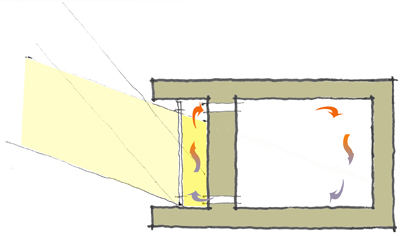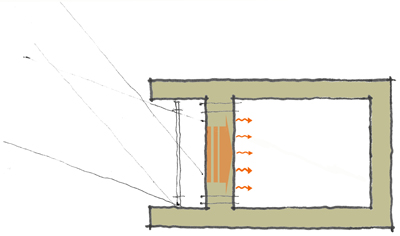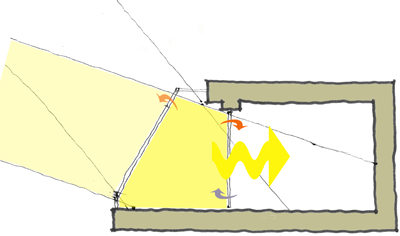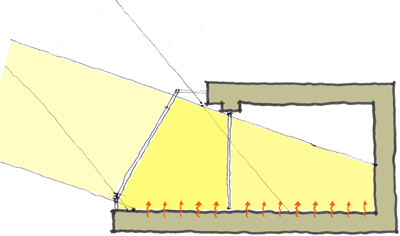Solar Energy
NIGHT TIME HEATING – Trombe wall
Trombe wall day time
Through the glass, the sun heats up the air and the mass of the wall. Heat absorption works better if the wall is painted a dark colour.
There are two controllable vents at high and low levels to allow convective heat transfer during the day. The air circulates through the building as the hotter air rises and the cooler, heavier air sinks.
Trombe wall night time
After sunset, the stored heat is slowly transferring through the wall into the room for about 6-10 hours, depending on the thickness and thermal characteristics of the wall. The wall should be built from high thermal mass material – i.e stone, brick, concrete, masonry, ceramic tile etc..- that can store heat during the sunny hours.
The glazing on the external face reduces heat loss to the outside.
DAY TIME HEATING – Sun space
Sun space – instant heat
An attached sunspace pre-warms the ventilation air for the parent house. It delivers heat to the adjacent building spaces by natural convection through openings (doors, windows or special vents) in the common wall.
Operable windows or vents are necessary to release excessive heat during the summer and sometimes, in the winter.
Sun space – thermal mass
The sunspace performs a passive solar heating function by not only transmitting solar radiation through its glazing but absorbing it on its interior surfaces.
Thermal mass helps to reduce interior temperature swings and delay the release of solar energy into occupied spaces.
SUMMERTIME COOLING
Thermal mass and Trombe wall – heat sink
If summertime overheating is an issue, the above process can be reversed by night-time cooling. The basic concept of the night time ventilation is to cool the building structure overnight in order to provide a heat sink during the occupancy period.
In the summer, the wall is shaded and the process is reversed. The vents in the wall are shut but the high and low level vents in the glazing are open. The air movement will have a cooling effect while the wall absorbs the heat from the room.




